 alt="Puer Surrounding Counties and Towns: Weekly & Special Local Markets Travel Guide"
/>
alt="Puer Surrounding Counties and Towns: Weekly & Special Local Markets Travel Guide"
/>
Ganlanba (Olive Plain ) in Jinghong City, Xishuangbanna
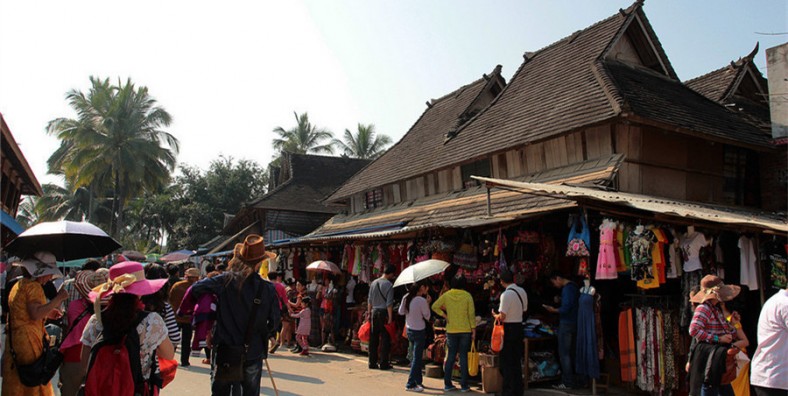
Chinese Name: 橄榄坝 (Gan Lan Ba)
Chinese Pinyin: Gan Lan Ba
English Name: Ganlanba
Type: ethnic culture, Dai village
Best Time: October to April
Opening Time: 8:00-18:00
Recomended Visiting Hours: half a day
Ticket: CNY 100 for Dai Minority Park.
Location: 40 kilometers from Jinghong City, Xishuangbanna Dai Autonomous Prefecture, Yunnan Province.
Ganlanba Dai Minority Park
Xishuangbanna Ganlanba (Olive Plain) in Jinghong City travel guide introduces the main attractions, entrance tickets booking, The best time to visit, How to Get there, the highlights, facts, history, photos, weather, accommodation, visiting routes, travel tips, tour maps of Ganlanba (Olive Plain) in Xishuangbanna(橄榄坝傣族园).
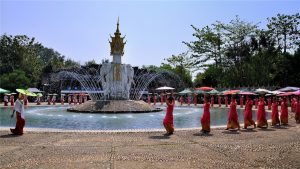
Ganlanba Dai Minority Park (Chinese name: 橄榄坝傣族园) is located in the southeast direction of Jinghong. It is a dwelling place for Dai minority people cause they have lived there generations to generations. Thus, the dense Dai minority culture can be found here. Ganlanba can be a representative to experience both the minority culture and the tropical atmosphere. Because Ganlanba with the lowest altitude which is about 530m in Yunnan, it is the hottest place. The hot climate makes Ganlanba as a rich fruits production area. Ganlanba in Xishuangbanna culture means “the imperial gardening village”. Inside it, there are two large villages called Man Chun Man (means flowers village) and Man Ting (means fruits village) separately. No matter which village you choose to visit, you can appreciate the typical Myanmar temple and Dai bamboo house.
Why is Ganlanba so special?
Hundreds of Dai families have lived there for generations, so there is a strong tropical and ethnic flavor, which is a combination of bamboo houses belonging to the Dai families and water scenery.
Ganlan Basin is at an elevation of only 530 meters, which is the lowest in Xishuangbanna. Meanwhile, it is the hottest place there. The hot climate provides for a wealth of natural products in the area. A wide variety of tropical fruits are produced there, such as coconuts, betel nuts, bananas, mangoes, lychees, starfruits, jackfruits, passion fruits, and so on. In addition to fresh fruits, Ganlan Basin also produces a lot of preserved fruits, so fresh fruit and preserved fruit markets can be seen everywhere.
Where is Ganlanba?
Ganlanba is located in the lower reaches of Lancang River, 40 kilometers from Jinghong City. In Dai language, it is called Menghan. There are hundreds of Dai households living in Ganlanba. Ganlanba is only 530 meters above sea level, being the lowest and hottest place in Xishuangbanna Dai Autonomous Prefecture. Locals give the title “the feather of peacocks” to describe Ganlanba. They regard Ganlanba as the peacock which is spreading its tail, it is a place with shining colors. Those bright Dai minority villages are looked like the decoration of the spreading tail.
How to Get to Ganlanba?
By water: take ship at the pier of Jinghong and go down along the river to Ganlanba, 2-3 hours
By bus: there are many buses departuring from the bus station near the Shuyuan Hotel of Jinghong City, 8.5 yuan for ticket.
Name of Meng Han (Ganlanba)
Ganlanba is the nickname of the Meng Han Dam which is located in the middle reach of Langcang River in Xishuangbanna. Meng Han means the rolling place of clothes. It is said that, when Sakyamuni had his tour in Xishuangbanna to spread Buddhism, locals of Ganlanba put white clothes on the ground to expressed their hospitality of him. But the white clothes was not enough to cover the whole Sakyamuni’s route in Ganlanba. So locals rolled the former period and used to put forwards to continue the road. Sakyamuni was so touch by this behavior. So he named this place to remember the honesty people here, thus it got the name “Meng Han”.
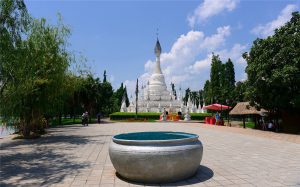
Main Attractions
Two Villages of Ganlanba
In Manting, which means “imperial garden village”, of Ganlan Basin, there are two big villages. One of them is Mansongman(曼松满), the garden village; the other is Manting(曼听), the flower and fruit village.
No matter which village you enter, you will see the typical Buddhist temple pagodasand traditional bamboo storied buildings of the Dai families. These villages are full of coconut trees, betelnut trees, mango trees, jackfruit trees, spiraea fruit plants and other tropical plants and flowers.
There is a large distance between the buildings in these villages. Tourists can have a walk in the courtyard and then ascend a bamboo storied building. The hospitable owner will warmly send cups of tea made with fresh tea leaves to them.
Things to Do
●Important Dai minority dwelling place
Ganlanba is one of the important Dai minority dwelling areas in Xishuangbanna, The splendid Dai minority culture constructs Ganlanba as an ethnic kingdom in Yunnan. Aiming to spread the unique culture to the world, Dai people had built some interesting folk villages. And inside these villages, the joyful activities between tourists and Dai people bring each one the deep memory.
●A big fruit garden
Ganlanba is a big fruit garden with rich fruit types. The most famous ones include coconut, pineapple, watermelon, banana, and tamarind fruit. The coconuts and pineapples selling in Jinghong are majorly produced in Ganlanba.
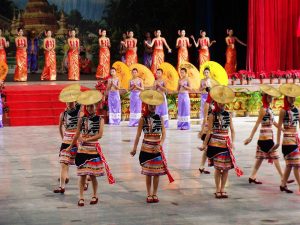
●The unique rubber forest scenery
The rubber forest is decorated by the tall and slim coconut grove. Ganlanba is one of the leading places to produce rubber.
●Dai minority villages
Ganlanba consists of 5 villages, about 300 families. Locals here are hospitality and still keeping their own living style. When you walk on the lane during the evening, you may hear the melody of Lusheng and the rhythm of Xiangjiao Drum.
●Dai Calendar New Year
At every Dai calendar New Year, that is, during the Water-Sprinkling Festival, all people who go to the fair in the town of Ganlan Basin will gothere specially to have a tour, to worship, and to celebrate the festival. It is very bustling during that time.
In addition, performances are given there at 3 o’clock every afternoon. After that, large-scale water-sprinkling activities are held on the plaza. Tourists can participate and make merry.
Recommended Tours
4 Days XishuangBanna Hiking Tour to Ganlanba Basin and Mekong River
4 Days Best XishuangBanna Tropical Forest and Ethnic Minorities Discovery
6 Days XishuangBanna and Puer Ethnic Culture Tour with Tea Culture and Ethnic Villages Discovery
Accommodate at Ganlanba
Nearly every family in the Dai village can provide accommodation. A prior reservation is preferred in the busy season.
Special reminder: Most of the local rural inns use solar water heaters. Don’t take your shower too late, otherwise there will be no hot water.
Nearby Attractions
♦Xishuangbanna Primeval Forest Park
Xishuangbanna Primeval Forest Park, also called Xishuangbanna Virgin Forest Park, is 8 kilometers east of the Jinghong City and north of the Lancang River. Situated in a river valley of 720 to 1,355 meters above sea level, the forest park has an area of 1,700 hectares of which 98% is covered by trees, and is thus the largest comprehensive ecological place of interest in the prefecture. The park gives prominence to the features of primeval forest, wild animals and ethnic culture and custom. It is highlighted by three major themes: primeval forest, wild animals and ethnic folklore. And you can also enjoy and play a part in the local ethnic activities such as the Dai Water Splashing Festival, Aini capture marriage custom and the grand ethnic performances.
♦Jinghong Wild Elephant Valley
Jinghong Wild Elephant Valley Forest Park (Chinese name: 野象谷公园) is a special theme park for Wild Asian Elephant sightseeing and observing and rainforest sightseeing. Wild Elephants Valley covers an area of 369 hectares by the Sancha River in Mengyang Town, and is situated 47 kilometers north of the city of Jinghong. With hills rolling gently at an altitude ranging between 747 and 1055 metres, the valley is covered by tropical rain forests, crisscrossed by rivers and streams, and teeming with such endangered species as Asian wild elephants, wild oxen, green peacocks and monkeys.
Manting Park, also called Chunhuan Park,(Chinese name: 春欢公园 or 曼听公园) is the oldest garden in Xishuangbanna area, which covers an area of 23,540 square meters. It used to be the imperial garden in ancient times. Its name “Chunhuan” in Dai language means “Soul”. The whole park can be divided into 8 sightseeing areas, they are National Cultural Square, Liana Zone, Tropical Orchid Garden, Peacock Garden, Lake Area and Buddhism Cultural Zone, Tree Planting Zone and Tea Garden. In the day time, people can appreciate the beauty of varied tropical plants and creatures, but at night, a different experience can let the tourists get a closer look of local customs and culture – Minority Dancing Show and Bonfire Party.
Best Time to Visit
Belonging to tropical rainforest climate, Xishuangbanna’s dry season is from November to April the next year and rainy season is from May to October. With annual average temperature of 21c, it has long summer and no winter. With cool and pleasant four seasons, the best time for traveling Xishuangbanna is from October to April the next year.
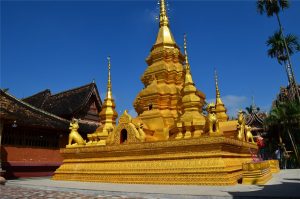
- The Water-Splashing Festival, the most important festival for the Dai People to celebrate New Year, is usually celebrated in the middle of April.
- Try to avoid Chinese public holidays, such as Labor Day (May 1st to 3rd) and National Day (October 1st to 7th). It is recommended that you start your day early so as to avoid crowds.
Useful Travel Tips
●It is better to prepare some mosquito products and sun block in case of insects and sunlight.
●Respect the local customs of Dai and other minorities.
●Do not touch the head of local monks.
●It is better to take T-shirt, short and slippers becauce it is too hot in Xishuangbanna.

 7 Days GolfingTour
7 Days GolfingTour
 8 Days Group Tour
8 Days Group Tour
 8 Days Yunnan Tour
8 Days Yunnan Tour
 7 Days Shangri La Hiking
7 Days Shangri La Hiking
 11 Days Yunnan Tour
11 Days Yunnan Tour
 6 Days Yuanyang Terraces
6 Days Yuanyang Terraces
 11 Days Yunnan Tour
11 Days Yunnan Tour
 8 Days South Yunnan
8 Days South Yunnan
 7 Days Tea Tour
7 Days Tea Tour
 8 Days Muslim Tour
8 Days Muslim Tour
 12 Days Self-Driving
12 Days Self-Driving
 4 Days Haba Climbing
4 Days Haba Climbing
 Tiger Leaping Gorge
Tiger Leaping Gorge
 Stone Forest
Stone Forest
 Yunnan-Tibet
Yunnan-Tibet
 Hani Rice Terraces
Hani Rice Terraces
 Kunming
Kunming
 Lijiang
Lijiang
 Shangri-la
Shangri-la
 Dali
Dali
 XishuangBanna
XishuangBanna
 Honghe
Honghe
 Kunming
Kunming
 Lijiang
Lijiang
 Shangri-la
Shangri-la
 Yuanyang Rice Terraces
Yuanyang Rice Terraces
 Nujiang
Nujiang
 XishuangBanna
XishuangBanna
 Spring City Golf
Spring City Golf
 Snow Mountain Golf
Snow Mountain Golf
 Stone Mountain Golf
Stone Mountain Golf













 What Our Customers Say?
What Our Customers Say?
